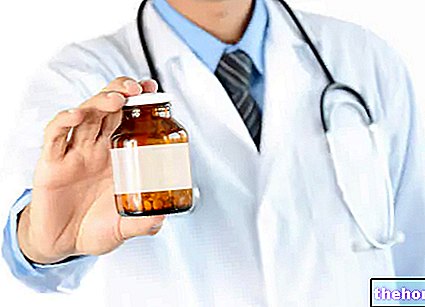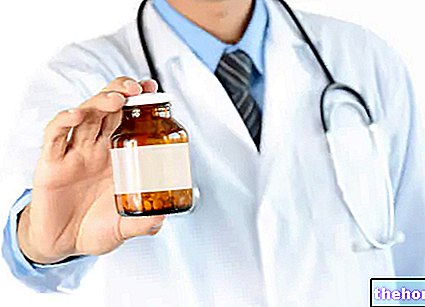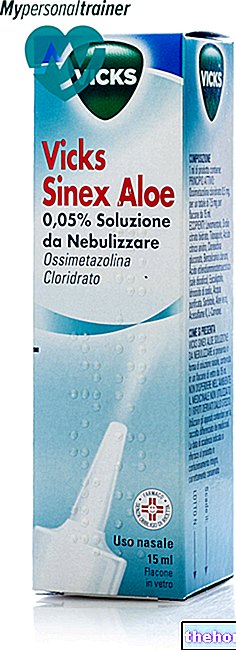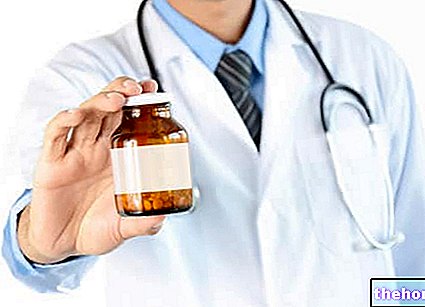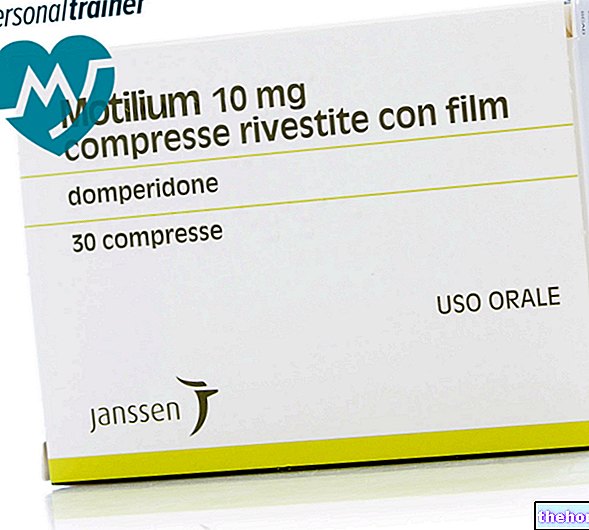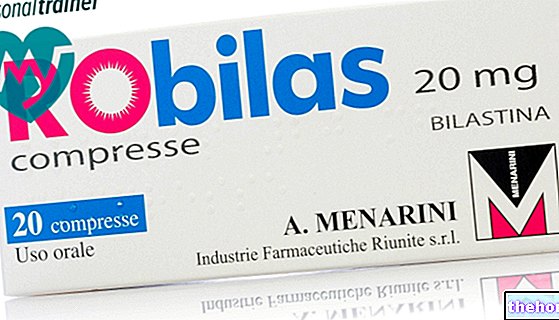Active ingredients: Human Chorionic Gonadotropin
Pregnyl 5000 IU powder and solvent for solution for injection for intramuscular use
Why is Pregnyl used? What is it for?
What is Pregnyl
Pregnyl contains the active ingredient human chorionic gonadotropin (hCG), a hormone belonging to the family of gonadotropins, hormones that regulate the activity of the reproductive organs in men and women (male and female gonads).
HGC, obtained from the urine of pregnant women, has the same effect in the body as luteinizing hormone (LH) which is produced by the pituitary gland of men and women. Together with another hormone produced by the pituitary gland, the hormone Follicle-stimulating (FSH), LH controls the action of the reproductive organs (ovaries in women and testes in men). These hormones are necessary for the normal growth and maturation of oocytes and sperm.
What Pregnyl is used for
Pregnyl is used in the treatment of male and female pathologies, in particular:
In the woman Pregnyl is used:
- to help release an oocyte from the ovaries (induction of ovulation) in women who do not produce oocytes (a condition called anovulation) or in whom the follicles (each containing an oocyte) do not mature;
- to induce the growth and development of numerous follicles in women undergoing assisted reproductive techniques (procedures that can help start a pregnancy);
- as a support to the last phase of the menstrual cycle which has the task of preparing the uterine mucosa to receive any embryo in the event of fertilization (luteal phase).
In man Pregnyl it is used:
- to treat a hereditary disease characterized by insufficient production of sex hormones by the testes (hypogonadotropic hypogonadism). Treatment with gonadotropin has also proved effective in some cases of alteration in the number and function of spermatozoa such as to reduce the ability to fertilize (idiopathic despermia);
- for the treatment of the delay in the development of secondary sexual characteristics (pubertal delay) associated with a decrease in the stimulation activity that the pituitary gland exerts on the testes, causing them to produce sex hormones (gonadotropic function of the pituitary);
- failure of one or both testicles to descend into the scrotum (cryptorchidism) not due to anatomical obstruction.
Contraindications When Pregnyl should not be used
Do not use Pregnyl if:
- you are allergic to chorionic gonadotropin or any of the other ingredients of this medicine (listed in section 6);
- has or has had cancer, known or suspected, whose onset and growth is favored by the presence of sex hormones, such as cancer of the ovary, uterus or breast in women and cancer of the prostate or breast in men;
- has malformations of the reproductive system that make pregnancy impossible;
- have or have had a common, benign form of cancer of the uterus (fibroid tumors of the uterus) that make pregnancy impossible.
Precautions for use What you need to know before taking Pregnyl
Talk to your doctor or pharmacist before using Pregnyl.
Although no cases of virus contamination have been reported associated with the administration of gonadotropins extracted from human urine, the risk of transmission of known or unknown pathogens cannot be totally excluded.
If she is a woman
Talk to your doctor before using Pregnyl if you have thyroid, adrenal and pituitary gland disorders (uncontrolled endocrine diseases).
Do not use Pregnyl to reduce body weight, as it has no effect on fat metabolism, fat distribution or appetite.
Ovarian hyperstimulation syndrome (OHSS)
If you are a woman taking Pregnyl for the treatment of infertility due to anovulation or incomplete maturation of the follicle (polycystic ovary syndrome), the previous administration of a drug containing FSH, a hormone that stimulates the maturation of the follicles, may lead to a condition where the ovaries are overstimulated and follicle growth becomes greater than normal.This medical condition is called ovarian hyperstimulation syndrome (OHSS).
This risk can be reduced by careful monitoring of follicular development during treatment. For this reason, the doctor will perform an ultrasound examination of the ovaries before FSH treatment and at regular intervals during therapy. He will also tell you to check your blood levels of estradiol, a hormone produced by the ovaries.
If unwanted ovarian hyperstimulation occurs (regardless of the type of assisted reproduction treatment you are undergoing) you must immediately stop taking FSH.
If you are developing ovarian hyperstimulation syndrome, you may not need to use Pregnyl as the use of a luteinizing gonadotropin, such as Pregnyl, could further interfere with the function of the ovaries and induce, in addition to multiple ovulation, a hyperstimulation syndrome. ovarian This is especially important if you have a tendency to form ovarian cysts.
Symptoms encountered in mild ovarian hyperstimulation are: gastrointestinal disorders such as abdominal pain, feeling sick (nausea), diarrhea, breast pain, mild to moderate enlargement of the ovaries and ovarian cysts. in association with ovarian hyperstimulation syndrome, temporary changes in liver function tests (liver function) have been reported.
In rare cases, a more severe form of ovarian hyperstimulation syndrome may occur which could be life-threatening. It is characterized by the presence of large ovarian cysts (which can rupture), by the collection of fluid in the abdominal lining membrane (ascites), by weight gain, frequently by a collection of fluid in the lining of the lungs ( hydrothorax) and occasionally from manifestations of occlusion of blood vessels (thromboembolic manifestations).
Multiple pregnancy and congenital malformations
During treatment with gonadotropin medicines, there is an "increased chance of a multiple pregnancy. Among patients treated to promote ovulation, pregnancies and multiple births occur more often than natural conception." However, this risk can be minimized by using the recommended dose. Furthermore, women who undergo assisted reproductive procedures are slightly more likely to develop birth defects than women who conceive naturally. This slightly higher incidence is thought to be related to different parental characteristics (eg mother's age, sperm characteristics) and the higher incidence of multiple pregnancies resulting from assisted reproductive techniques. There are insufficient data to establish that the use of gonadotropins in women undergoing assisted reproductive techniques is associated with an increased risk of congenital malformations.
Abortion
Women who undergo assisted reproductive procedures have a higher risk of miscarriage than others.
Complications of pregnancy
There is a slightly higher risk of ectopic pregnancy (or ectopic pregnancy) in women with fallopian tube problems. Since infertile women who undergo assisted reproductive techniques, particularly in vitro reproduction (IVF), often have tubal abnormalities, in these cases the likelihood of pregnancies developing outside the uterus (ectopic pregnancies) could increase. Therefore, the physician must perform an early ultrasound evaluation to rule out the possibility of pregnancy outside the uterus.
Blood clots (Thrombosis)
Treatment with gonadotropins may increase the risk of developing a blood clot in a blood vessel (venous or arterial thrombosis) in women who have a risk factor for this condition. Before starting treatment, talk to your doctor especially if:
- you or any of your family members have had a thrombosis;
- are overweight (body mass index> 30 kg / m2);
- have blood clotting abnormalities (thrombophilia).
If you fall into these cases, your doctor will weigh the benefits of the treatment against the potential risks to you. However, it should be noted that pregnancy itself leads to an increased risk of thrombosis.
If she is a man
Treatment with gonadotropin causes an increase in the production of hormones produced by the adrenal glands (androgens). Your doctor will therefore closely monitor you if:
- has a clinical syndrome, latent or manifest, which determines the inability of the heart to supply blood in an adequate quantity compared to the actual demand of the organism (heart failure),
- your kidneys are unable to perform normal functions (kidney failure);
- have high blood pressure (hypertension);
- have or have had episodes of epilepsy or migraine.
The increased production of androgens can occasionally cause an aggravation or exacerbation of these pathologies.
Children
Pregnyl should be used with caution in children who have not yet completed sexual development (prepubertal) in order to avoid premature closure of the ends of the long bones (epiphysis) or early sexual development. The physician should regularly assess the degree of skeletal maturation of these patients.
Interactions Which drugs or foods can modify the effect of Pregnyl
Tell your doctor or pharmacist if you are taking, have recently taken or might take any other medicines.
In the absence of compatibility studies, interactions of Pregnyl with other medicinal products, even those in common use, cannot be excluded.
If you do a serum or urine pregnancy test after using Pregnyl and up to 10 days later, you may get a false test result. If in doubt, ask your doctor.
Warnings It is important to know that:
Pregnancy, breastfeeding and fertility
If you are pregnant or breast-feeding, think you may be pregnant or are planning to have a baby, ask your doctor or pharmacist for advice before using this medicine.
Pregnyl can be used to support the luteal phase, but should not be used during pregnancy.
Pregnyl should not be used while breastfeeding.
Driving and using machines
Pregnyl does not affect the ability to drive or use machines.
For those who carry out sports activities
The use of the drug without therapeutic necessity constitutes doping and can in any case determine positive anti-doping tests.
Dosage and method of use How to use Pregnyl: Dosage
Always use this medicine exactly as your doctor or pharmacist has told you. If in doubt, consult your doctor or pharmacist. Pregnyl comes in the form of a powder which must be dissolved before injection. Use the solvent vial contained in the pack to dissolve the powder and obtain a solution. The reconstituted solution should be used immediately.
Take Pregnyl by injection by giving the solution slowly into a muscle (for example in the buttock, thigh or upper arm).
Dosage in women
Induction of ovulation in cases of infertility due to anovulation or failure of the follicle:
The recommended dose is an injection of 5,000 - 10,000 IU (International Units) of Pregnyl to complement previous treatment with an FSH-based preparation.
Preparation of the follicles for sampling during the application of controlled ovarian hyperstimulation programs:
The recommended dose is an injection of 5,000 - 10,000 IU Pregnyl to complement a previous treatment with an FSH-based preparation.
Support for the luteal phase:
The recommended dose is 2-3 repeated injections, each with 1500 - 3000 IU of Pregnyl, in the 9 days following ovulation or embryo transfer into the uterus.
Dosage in man
Hypogonadotropic hypogonadism:
The recommended dose is a 1500 IU injection of Pregnyl 2-3 times per week. In case of infertility, the Pregnyl dose should be administered in combination with an FSH-based preparation (at a dose of 75 IU), daily or 2-3 times a week. This treatment must be continued for at least 3 months before there is an improvement in sperm production (spermatogenesis). Any testosterone replacement therapy should be suspended during treatment. In some cases the improvement in spermatogenesis thus obtained can then be maintained using only human chorionic gonatropin.
Use in children and adolescents
Pubertal delay associated with deficit of gonadotropic function of the pituitary:
The recommended dose is one 1500 IU injection 2-3 times a week, for at least 6 months.
Cryptorchidism not due to anatomical obstruction:
The recommended dose in children over six years of age is one injection of 1500 IU twice a week for 6 weeks; if necessary, the treatment can be repeated.
If you forget to use Pregnyl
Do not use a double dose to make up for a forgotten dose.
If you stop taking Pregnyl
If you have any further questions on the use of this medicine, ask your doctor or pharmacist.
Overdose What to do if you have taken too much Pregnyl
The toxicity of gonadotropin medicines obtained from the urine of women has been shown to be very low. However, it is possible that a very high dose of chorionic gonadotropin can cause excessive stimulation of the ovaries (ovarian hyperstimulation syndrome).
Side Effects What are the side effects of Pregnyl
Like all medicines, this medicine can cause side effects, although not everybody gets them.
Allergic reactions at the injection site, such as pain and rash, and generalized reactions such as widespread rash and fever have occasionally been reported with the use of gonadotropin medicines obtained from urine.
In women:
- abdominal pain, feeling sick (nausea), diarrhea, breast pain, mild to moderate enlargement of the ovaries and ovarian cysts usually. These effects are related to mild ovarian hyperstimulation syndrome;
- large ovarian cysts (which can rupture), collection of fluid in the abdominal lining membrane (ascites), weight gain and collection of fluid in the lining of the lungs (hydrothorax). These effects are usually related to a more severe form of ovarian hyperstimulation syndrome;
- occlusion of blood vessels (thromboembolism), when gonadotropin therapy is associated with FSH. This effect may occur rarely and is usually associated with severe ovarian hyperstimulation syndrome.
In the "man:
- water and sodium retention. This undesirable effect results from an excessive production of androgens and can occasionally occur after the administration of high doses of human chorionic gonadotropin;
- enlargement of the mammary gland (gynecomastia) which can occur in rare cases.
Reporting of side effects
If you get any side effects, talk to your doctor or pharmacist. This includes any possible side effects not listed in this leaflet. You can also report side effects directly via www.agenziafarmaco.it/it/responsabili. By reporting side effects you can help provide more information on the safety of this medicine.
Expiry and Retention
Keep this medicine out of the sight and reach of children.
Keep the vial in the outer carton to protect the medicine from light.
Store in the refrigerator at a temperature between 2 and 15 ° C.
The reconstituted solution should be used immediately.
Do not use this medicine after the expiry date which is stated on the package after "EXP". The expiry date refers to the last day of that month. The expiry date indicated refers to the product in intact packaging, correctly stored.
Do not use Pregnyl if you notice that the reconstituted solution contains particles or if the solution is not clear.
Do not throw any medicines via wastewater or household waste. Ask your pharmacist how to throw away medicines you no longer use. This will help protect the environment.
Other information
What Pregnyl contains
- The active substance is human chorionic gonadotropin (hCG). Each vial of powder contains 5000 IU of human chorionic gonadotropin.
- The other ingredients are: sodium carboxymethylcellulose, mannitol, anhydrous dibasic sodium phosphate and anhydrous monobasic sodium phosphate.
Each vial of solvent contains 9 mg of sodium chloride dissolved in 1 ml of water for injections.
Description of Pregnyl appearance and contents of the pack
Pregnyl contains powder and solvent for solution for injection.
Each pack contains:
- 1 or 3 colorless 2 ml glass vials containing the white, dry powder e
- 1 or 3 colorless 1 ml glass vials containing a clear and colorless aqueous solution.
The powder and solvent vials are placed in a thermoformed container inside a cardboard box.
Not all pack sizes may be marketed.
Source Package Leaflet: AIFA (Italian Medicines Agency). Content published in January 2016. The information present may not be up-to-date.
To have access to the most up-to-date version, it is advisable to access the AIFA (Italian Medicines Agency) website. Disclaimer and useful information.
01.0 NAME OF THE MEDICINAL PRODUCT
PREGNYL 5000 IU POWDER AND SOLVENT FOR SOLUTION FOR INJECTION FOR INTRAMUSCULAR USE
02.0 QUALITATIVE AND QUANTITATIVE COMPOSITION
Pregnyl consists of lyophilized powder and solvent for solution for injection.
The active ingredient of Pregnyl is human chorionic gonadotropin (hCG), obtained from the urine of pregnant women, with luteinizing activity.
The vials of lyophilized powder contain 5000 IU of human chorionic gonadotropin (hCG).
For the full list of excipients, see section 6.1.
03.0 PHARMACEUTICAL FORM
Powder and solvent for solution for injection for intramuscular use. The powder is white, dry. The solvent is a clear, colorless aqueous solution.
4. INFORMATION
04.0 CLINICAL INFORMATION
04.1 Therapeutic indications
In the woman:
• induction of ovulation in cases of infertility due to anovulation or failure of the follicle to mature;
• preparation of the follicles for sampling, during the application of controlled ovarian hyperstimulation programs;
• support for the luteal phase.
In the "man:
• hypogonadotropic hypogonadism (some cases of idiopathic despair have also been shown to respond positively to treatment with gonadotropin);
• pubertal delay associated with a deficit of the gonadotropic function of the pituitary gland;
• cryptorchidism not due to anatomical obstruction.
04.2 Posology and method of administration
Dosage in women:
• induction of ovulation in cases of infertility due to anovulation or failure of the follicle to mature:
usually an injection of 5000-10000 IU of Pregnyl to complete the treatment with an FSH-based preparation;
• preparation of the follicles for sampling, during the application of controlled ovarian hyperstimulation programs:
usually an injection of 5000-10000 IU of Pregnyl to complete the treatment with an FSH-based preparation;
• luteal phase support:
2 - 3 repeated injections, each with 1500-3000 IU of Pregnyl, in the 9 days following ovulation or embryo transfer.
Dosage in man:
• hypogonadotropic hypogonadism:
1500 IU of Pregnyl 2-3 times a week. If infertility is the main problem, the Pregnyl dose should be administered in combination with an FSH-based preparation (at a dose of 75 IU), daily or 2-3 times a week. This treatment should be continued for at least 3 months before spermatogenesis improves. Any testosterone replacement therapy should be discontinued during treatment.
Once obtained, the improvement in spermatogenesis can be maintained in some cases with the use of human chorionic gonadotropin alone;
• pubertal delay associated with a deficit of the gonadotropic function of the pituitary gland:
1500 IU 2-3 times a week, for at least 6 months;
• cryptorchidism, not due to anatomical obstruction:
in children over six years of age: 1500 IU 2 times a week for 6 weeks.
If necessary, the treatment can be repeated.
Method of administration
The preparation is reconstituted by adding the solvent to the lyophilized powder. The reconstituted solution of Pregnyl should be administered slowly by intramuscular injection.
04.3 Contraindications
• Hypersensitivity to the active substance or to any of the excipients listed in section 6.1.
• Known or suspected hormone-sex-dependent cancers, such as ovarian, breast and uterine cancer in women and prostate or breast cancer in men.
• Malformations of the sexual organs incompatible with pregnancy.
• Fibroid tumors of the uterus incompatible with pregnancy.
04.4 Special warnings and appropriate precautions for use
Although no cases of viral contamination associated with the administration of gonadotropins extracted from human urine have been reported, the risk of transmission of known or unknown pathogens cannot be totally excluded.
In the woman:
• after induction of ovulation with preparations containing gonadotropins, there is an increased risk of multiple pregnancies;
• Since infertile women undergoing assisted reproduction, particularly IVF, often have tubal abnormalities, the incidence of ectopic pregnancies may increase. It is therefore important to confirm that the pregnancy is intrauterine, with an early ultrasound evaluation;
• the incidence of unfinished pregnancies in women undergoing assisted reproductive techniques (ARF) is higher than in the normal population;
• the presence of uncontrolled non-gonadal endocrinopathies (eg thyroid, adrenocortical or pituitary disorders) must be excluded;
• the incidence of congenital malformations after assisted reproductive techniques may be slightly higher than that after spontaneous conception. This slightly higher incidence is thought to be related to different parental characteristics (eg age of the mother, characteristics sperm) and with the highest incidence of multiple gestations resulting from assisted reproductive techniques. There are no indications that the use of gonadotropins during assisted reproductive techniques is associated with an increased risk of congenital malformations.
Unwanted ovarian hyperstimulation:
• in patients treated for infertility due to anovulation or incomplete maturation of the follicle, the previous administration of an FSH-based preparation can lead to undesirable ovarian hyperstimulation. Therefore, ultrasound assessment of follicular development and determination of estradiol levels should be performed prior to treatment with FSH and at regular intervals during therapy. Levels of estradiol can increase extremely rapidly, for example more than double every day for 2 or 3 consecutive days, and eventually reach excessively high values. The diagnosis of unwanted ovarian hyperstimulation can be confirmed with ultrasound examination.
• Should unwanted ovarian hyperstimulation occur (ie not as part of a preparatory treatment for IVF / ET, GIFT or ZIFT) the administration of the FSH-based preparation must be immediately suspended. In such cases Pregnyl should not be administered as the use of a gonadotropin with LH activity can induce, in addition to multiple ovulation, an ovarian hyperstimulation syndrome. This warning is particularly important in the case of patients with polycystic ovary syndrome.
• The clinical symptoms of mild ovarian hyperstimulation syndrome are characterized by gastrointestinal disorders (pain, nausea, diarrhea), breast pain, and mild to moderate enlargement of the ovaries and ovarian cysts. In association with ovarian hyperstimulation syndrome, transient abnormalities of liver function tests have been reported, which may be indicative of liver dysfunction and which may be accompanied by morphological changes on liver biopsy.
• In rare cases, a more severe form of ovarian hyperstimulation syndrome may occur, which can be life threatening. It is characterized by the presence of large ovarian cysts (which can rupture), ascites, weight gain, often hydrothorax and occasionally thrombo-embolic manifestations.
• Women with a generally recognized risk factor for thrombosis, such as personal or family history, severe obesity (Body Mass Index> 30 kg / m2) or thrombophilia, may have an increased risk of venous or arterial thromboembolic events during or following treatment with gonadotropins.
In these women, the benefits of IVF treatment must be weighed against the risks. It should be noted, however, that even pregnancy itself leads to an increased risk of thrombosis.
• Pregnyl should not be used to reduce body weight. HCG has no effect on fat metabolism, fat distribution or appetite.
In the "man:
• treatment with hCG causes an increase in androgen production. Therefore:
• Patients with latent or manifest heart failure, renal failure, hypertension, epilepsy or migraine (or a history of these diseases) should be kept under close medical surveillance, as increased androgen production may occasionally cause an aggravation or a resurgence of these pathologies;
• Human Chorionic Gonadotropin should be used with caution in prepubertal subjects to avoid premature closure of the epiphyses or early sexual development. The degree of skeletal maturation should be checked regularly.
04.5 Interactions with other medicinal products and other forms of interaction
Interactions of Pregnyl with other medicines have not been studied; interactions with commonly used medicinal products cannot therefore be excluded.
After administration, Pregnyl may interfere for up to ten days with the immunological determination of serum and urinary hCG, leading to a false positive pregnancy test.
04.6 Pregnancy and breastfeeding
Pregnancy
Pregnyl can be used to support the luteal phase, but should not be used later in pregnancy.
Feeding time
It is not intended for use during lactation.
04.7 Effects on ability to drive and use machines
Pregnyl has no effect on alertness and ability to concentrate.
04.8 Undesirable effects
Disorders of the immune system
In rare cases, generalized rash or fever may occur.
General disorders and administration site conditions
Allergic reactions, mostly localized at the injection site, such as pain and rash, but also widespread, such as rash and fever, have occasionally been reported with the use of gonadotropin preparations obtained from urine.
Allergic reactions, mainly pain and / or rash at the injection site, have been reported occasionally.
In the woman:
Vascular pathologies
In rare cases, thromboembolism has been associated with FSH / hCG therapy, usually associated with severe ovarian hyperstimulation syndrome (OHSS).
Respiratory, thoracic and mediastinal disorders
Hydrothorax, as a complication of severe ovarian hyperstimulation syndrome.
Gastrointestinal disorders
Abdominal pain and gastrointestinal symptoms such as nausea and diarrhea, related to a mild OHSS. Ascites, as a complication of severe OHSS.
Diseases of the reproductive system and breast
Unwanted ovarian hyperstimulation, mild or severe ovarian hyperstimulation syndrome (see section 4.4).
Sore breasts, mild to moderate enlargement of the ovaries and ovarian cysts, related to mild ovarian hyperstimulation syndrome. Large ovarian cysts (prone to rupture) are usually associated with a more severe form of ovarian hyperstimulation syndrome.
Diagnostic tests
Weight gain as a feature of severe ovarian hyperstimulation syndrome.
In the "man:
Metabolism and nutrition disorders
After administration of high doses of human chorionic gonadotropin, water and sodium retention has occasionally been observed; this effect is due to an excessive production of androgens.
Diseases of the reproductive system and breast
In rare cases, treatment with human chorionic gonadotropin can cause gynecomastia.
Reporting of suspected adverse reactions
The reporting of suspected adverse reactions that occur after the authorization of the medicinal product is important, as it allows continuous monitoring of the benefit / risk ratio of the medicinal product. Healthcare professionals are asked to report any suspected adverse reactions via the Italian Medicines Agency. , website: http://www.agenziafarmaco.gov.it/it/responsabili.
04.9 Overdose
It has been shown that the toxicity of gonadotropin preparations obtained from the urine of women is very low. Nevertheless, it is possible that a very high dose of hCG may lead to ovarian hyperstimulation syndrome (see section 4.4).
05.0 PHARMACOLOGICAL PROPERTIES
05.1 Pharmacodynamic properties
Pharmacotherapeutic group: Gonadotropins and other ovulation stimulants, gonadotropins.
ATC code: G03GA01
Pregnyl contains Human Chorionic Gonadotropin (hCG), which has LH activity, which is essential for the normal growth and maturation of female and male gametes, and for gonadal steroidogenesis.
In the woman:
Pregnyl is used as a substitute for the endogenous LH surge that occurs in the middle of the menstrual cycle in order to induce the final stage of follicular maturation leading to ovulation. Pregnyl is also administered as a substitute for endogenous LH during the luteal phase.
In the "man:
Pregnyl is used for the stimulation of Leydig cells in order to promote the production of testosterone.
05.2 Pharmacokinetic properties
Maximum plasma hCG levels are reached approximately 6 hours after administration of a single dose of hCG.
About 80% of human chorionic gonadotropin is metabolised, mainly by the kidneys.
After IM administration, the apparent elimination half-life is approximately 2 days.
Based on the recommended posology and elimination half-life data, accumulation of hCG in the body is very unlikely.
05.3 Preclinical safety data
No information.
06.0 PHARMACEUTICAL INFORMATION
06.1 Excipients
Each 5,000 IU Pregnyl vial contains: sodium carboxymethylcellulose; mannitol; anhydrous dibasic sodium phosphate; anhydrous monobasic sodium phosphate.
Each solvent ampoule contains: sodium chloride (9 mg) and water for injections (1 ml).
06.2 Incompatibility
In the absence of incompatibility studies, this medicinal product must not be mixed with other medicinal products.
06.3 Period of validity
Under the expected storage conditions, Pregnyl has a shelf life of 3 years.
Pregnyl can be used up to the expiration date indicated on the package.
Since the vial, once opened, cannot be closed again in such a way as to guarantee the sterility of the contents, the solution must be used immediately after its reconstitution.
06.4 Special precautions for storage
Keep the vial in the outer carton to protect the medicine from light.
Store in the refrigerator at a temperature between 2 and 15 ° C.
06.5 Nature of the immediate packaging and contents of the package
2ml colorless glass vial for lyophilized powder; 1 ml colorless glass vial for the solvent.
The vials of lyophilized powder and the vials of solvent are placed in a thermoformed container inserted in turn in a cardboard box.
06.6 Instructions for use and handling
See section 4.2 (Posology and method of administration).
Unused medicine and wastes derived from this medicine must be disposed of in accordance with local regulations.
07.0 MARKETING AUTHORIZATION HOLDER
N.V. Organon
Kloosterstraat 6
5349 AB Oss (Netherlands)
Representative for Italy:
MSD Italia S.r.l.
Via Vitorchiano, 151
00189 Rome
08.0 MARKETING AUTHORIZATION NUMBER
1 vial of 5000 IU powder + 1 vial of solvent 1 ml A.I.C. n. 033717036
3 powder vials 5000 IU + 3 solvent vials 1 ml A.I.C. n. 033717024
09.0 DATE OF FIRST AUTHORIZATION OR RENEWAL OF THE AUTHORIZATION
Date of first authorization: 20 December 1999
Date of most recent renewal: December 2009
10.0 DATE OF REVISION OF THE TEXT
May 2015

